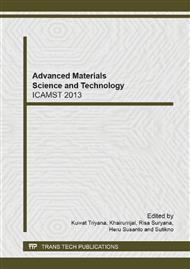[1]
Ganapati D. Yadav, Jayesh J. Nair, Sulfated zirconia and its modified versions as promising catalysts for industrial processes, Microporous and Mesoporous Materials. 33 (1999) 1–48.
DOI: 10.1016/s1387-1811(99)00147-x
Google Scholar
[2]
G. Boskovic, A. Zarubica, P. Putanov, Precursor affected properties of nanostructured sulfated zirconia: morphological, textural and structural correlations, J. Optoelect. Adv. Mater. 7 (2007) 2251-2257.
Google Scholar
[3]
Tursiloadi, S., Imai, H. and Hirashima, H., Preparation and characterization of mesoporous titania-alumina ceramic by modified sol gel method, J. Non-Crystalline Solids 350 (2004) 271-276.
DOI: 10.1016/j.jnoncrysol.2004.09.010
Google Scholar
[4]
Weissman, J.G., Ko, E. I and Kaytal, S., Titania-zirconia mixed oxide aerogels as supports for hydrotreating catalysts, Appl. Catal. A. 94 (1993) 45-59.
DOI: 10.1016/0926-860x(93)80044-q
Google Scholar
[5]
Saur, O., Bensitel, M., Saad, A. B. H., Lavalley, J. C., Tripp, C. P., Morrow, B. A. J. Catal. 9 (1986) 104.
Google Scholar
[6]
Yamaguchi, T., Recent progress in solid superacids, Appl. Catal. 61 (1990) 1.
Google Scholar
[7]
Sohn, J. R., Kim, H. W., Park, M. Y., Park, E. H., Kim, J. T., Park, S. E., Highly active catalyst of NiO-ZrO2 modified with H2SO4 for ethylene dimerization, Appl. Catal. A: General 128 (1995) 127.
DOI: 10.1016/0926-860x(95)00057-7
Google Scholar
[8]
C. Morterra, G. Cerrato, C. Emanual, End-on surface coordinated (adsorbed) CO2: a specific ligand for surface Lewis acidic centres, Mater. Chem. Phys. 29 (1991) 447.
DOI: 10.1016/0254-0584(91)90039-w
Google Scholar
[9]
M. Bensitel, O. Saur, J. C Lavalley, B.A. Morrow, An infrared study of sulfated zirconia, Mater. Chem. Phys. 19 (1988) 147-156.
DOI: 10.1016/0254-0584(88)90007-7
Google Scholar
[10]
C. Morterra, G. Cerrato, F. Pinna, M. Signoretto, G. Strukul, On the acid-catalyzed isomerization of light paraffins over a ZrO2/SO4 system: the effect of hydration, J. Catal 149 (1994) 181-188.
DOI: 10.1006/jcat.1994.1283
Google Scholar
[11]
F.R. Chen, G. Coudurier, J.F. Joly, J. C Vedrine, Superacid and catalytic properties of sulfated zirconia, J. Catal. 143 (1993) 616-626.
DOI: 10.1006/jcat.1993.1304
Google Scholar
[12]
X. Bokhimi, A. Morales, E. Ortiz, T. Lopez, R. Gomez and J. Navarrete, Sulfate ions in titania polymorphs, J. Sol-Gel Sci. and Tech., 29 (2004) 31-40.
DOI: 10.1023/b:jsst.0000016135.02238.0e
Google Scholar


